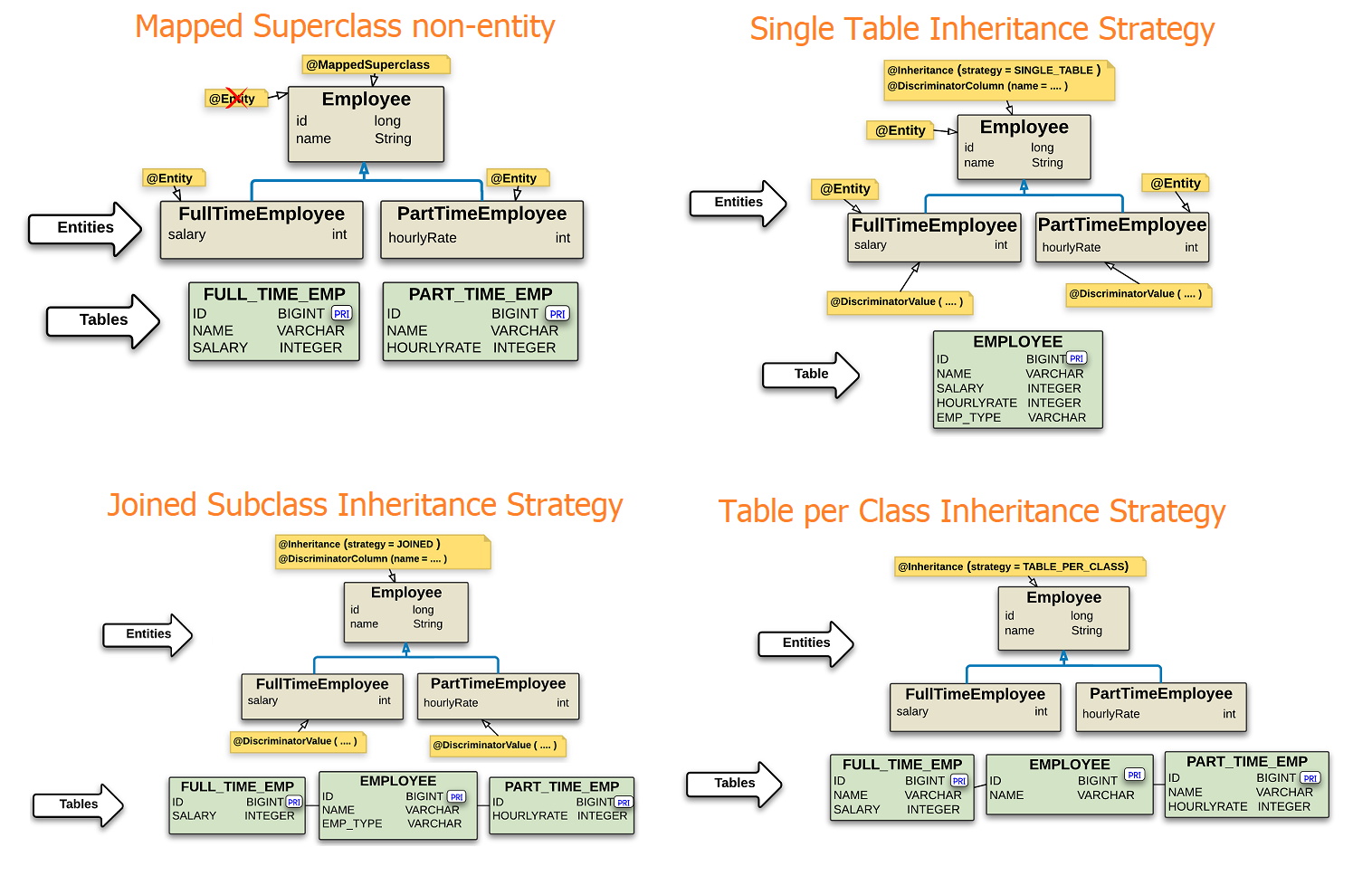Spring Boot: JPA Inherence
Spring Boot JPA Inherence
📘 JPA Inherence
Spring Boot provides an implementation of the Java Persistence API (JPA) to simplify database access: ORM (Object-Relational Mapping)
In JPA, entity classes represent tables in the database, and relationships between entities are mapped using annotations.
Inheritance is a fundamental concept of POO, but Relational databases have no concept of inheritance neither NoSQL (MongoDB, DymamoDB), so persisting inheritance in a SQL and NoSQL database _has its own particular way.
1 Inherence and JPA
Inheritance is a fundamental concept of POO, but Relational databases have no concept of inheritance neither NoSQL (MongoDB, DymamoDB), so persisting inheritance in a SQL and NoSQL database has its own particular way.
Because
relational databaseshave no concept ofinheritance, there is no standard way of implementinginheritancein database, so the hardest part of persistinginheritanceis choosing how to represent the inheritance in the database.
JPA defines several inheritance mechanisms, mainly defined though the @Inheritance annotation or the <inheritance> element.
There are three inheritance strategies defined from the InheritanceType enum:
SINGLE_TABLE:SINGLE_TABLETABLE_PER_CLASS: TABLE_PER_CLASSJOINED:JOINED
- Single table inheritance is the default with discriminator values,
- and table per class is an optional feature of the JPA spec, so not all providers may support it.
- in joined strategy each class in the hierarchy is mapped to its table.
MAPPED SUPERCLASS
JPA also defines a mapped superclass concept defined through the @MappedSuperclass annotation or the <mapped-superclass> element.
A mapped superclass is not a persistent class, but allows common mappings to be defined for its subclasses.
MAPPED SUPERCLASS: @MappedSuperClass
Links:
Each strategy has its own advantages and trade-offs in terms of performance, flexibility, and database structure. The choice depends on the specific requirements of our application.
1.1 SINGLE_TABLE
The SINGLE_TABLE strategy maps all classes in the inheritance hierarchy to a single database table. This is the default strategy.
Simple example:
1.2 TABLE_PER_CLASS
The TABLE_PER_CLASS strategy creates a separate table for each concrete class in the hierarchy.
Simple example:
1.3 JOINED
The JOINED strategy creates a table for the base class and separate tables for each subclass, linked by foreign keys.
Simple example:
2 JPA Inheritance Strategies
In
Java Persistence API (JPA), mapping inheritance hierarchies to relational databases presents unique challenges. JPA offers three main strategies to handle this object-relational impedance mismatch:
- SINGLE_TABLE: All classes are mapped to one table in the hierarchy .
- TABLE_PER_CLASS: Each concrete class gets its own table.
- JOINED: The base class and each subclass have their own tables.
The following table summarizes the key aspects of each strategy:
| Strategy | Pros | Cons | Use Case |
|---|---|---|---|
SINGLE_TABLE |
- Simple and fast queries - Easy to add new types - Good performance |
- Potential for many nullable columns - Table can become large - Limited to 31 subclasses (due to dtype limitation) |
Best for hierarchies with few subclasses and little variation in properties |
TABLE_PER_CLASS |
- Data integrity (no null columns) - Easy to add new types - Each table is self-contained |
- Complex queries across hierarchy - Potential for duplicate columns - Can be slower for polymorphic queries |
Suitable when subclasses have many unique attributes and polymorphic queries are rare |
JOINED |
- Normalized database design - Flexible for future changes - Supports polymorphic queries efficiently |
- Requires joins for queries - Inserts and updates affect multiple tables - Can be slower for deep hierarchies |
Ideal for complex hierarchies where data integrity and normalization are important |
The choice of strategy should be based on your specific requirements, including performance needs, data structure complexity, and anticipated future changes.
